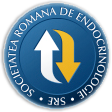
- Login
- Register
- Home/Current Issue
- About the journal
- Editorial board
- Online submission
- Instructions for authors
- Subscriptions
- Foundation Acta Endocrinologica
- Archive
- Contact
 Romanian Academy
Romanian Academy
 The Publishing House of the Romanian Academy
The Publishing House of the Romanian Academy

ACTA ENDOCRINOLOGICA (BUC)
The International Journal of Romanian Society of Endocrinology / Registered in 1938in Web of Science Master Journal List
Acta Endocrinologica(Bucharest) is live in PubMed Central
Journal Impact Factor - click here.

-
Case Report
Ariturk Z, Islamoglu Y, Tekbas E, Cil H, Soydinc S, Yazici M
An Unusual Presentation of Hyperthyroidism: Atrioventricular Complete Heart BlockActa Endo (Buc) 2011 7(3): 405-409 doi: 10.4183/aeb.2011.405
AbstractComplete heart block associated with hyperthyroidism is infrequent, and the diagnosis of hyperthyroidism is usually not considered in the absence of tachycardia. A 55-year-old woman was admitted to our emergency clinic with dizziness and syncope attack. Her electrocardiogram showed complete heart block.\r\nHyperthyroidism had been diagnosed, and she had been treated with propylthiouracil as an anti-thyroid treatment 3 years ago, although she had not taken this drug during the last 2 months. Her thyroid function tests showed hyperthyroidism. Antithyroid treatment was started again. Her rhythm returned from complete atrioventricular block to normal sinus rhythm\r\non the seventh day of hospitalization. -
Perspectives
Lu WJ, Qiu YR, Wu YW, Li J, Chen R, Chen SN, Lin YY, OuYang LY, Chen JY, Chen F, Qiu SD
Radiomics Based on Two-Dimensional and Three-Dimensional Ultrasound for Extrathyroidal Extension Feature Prediction in Papillary Thyroid CarcinomaActa Endo (Buc) 2022 18(4): 407-416 doi: 10.4183/aeb.2022.407
AbstractAim. To evaluate the diagnostic performance of radiomics features of two-dimensional (2D) and threedimensional (3D) ultrasound (US) in predicting extrathyroidal extension (ETE) status in papillary thyroid carcinoma (PTC). Patients and Methods. 2D and 3D thyroid ultrasound images of 72 PTC patients confirmed by pathology were retrospectively analyzed. The patients were assigned to ETE and non-ETE. The regions of interest (ROIs) were obtained manually. From these images, a larger number of radiomic features were automatically extracted. Lastly, the diagnostic abilities of the radiomics models and a radiologist were evaluated using receiver operating characteristic (ROC) analysis. We extracted 1693 texture features firstly. Results. The area under the ROC curve (AUC) of the radiologist was 0.65. For 2D US, the mean AUC of the three classifiers separately were: 0.744 for logistic regression (LR), 0.694 for multilayer perceptron (MLP), 0.733 for support vector machines (SVM). For 3D US they were 0.876 for LR, 0.825 for MLP, 0.867 for SVM. The diagnostic efficiency of the radiomics was better than radiologist. The LR model had favorable discriminate performance with higher area under the curve. Conclusion. Radiomics based on US image had the potential to preoperatively predict ETE. Radiomics based on 3D US images presented more advantages over radiomics based on 2D US images and radiologist. -
Endocrine Care
Oksa S, Luukkaala T, M?enp?? J
The antioestrogen toremifene has luteotropic effects in women suffering from premenstrual mastalgiaActa Endo (Buc) 2008 4(4): 425-432 doi: 10.4183/aeb.2008.425
AbstractBackground. Prior studies examining cyclic mastalgia and sex hormones have failed to\r\nreveal any specific endocrine cause and their results of them are inconsistent.\r\nAim. To evaluate luteal hormonal levels in women with marked premenstrual mastalgia\r\nin response to toremifene.\r\nMethods. In a double-blind crossover randomization procedure after one baseline cycle,\r\n32 women were randomized to receive 20 mg toremifene, and 30 women placebo from cycle\r\nday 15 until the next menstruation for three menstrual cycles. After a wash-out cycle the women\r\nwere crossed over to receive placebo and toremifene, respectively. The luteal hormonal levels\r\nwere measured at baseline, and during the third cycle of toremifene and placebo. The study was\r\nsetup in a general practice population from two Finnish hospital districts. Serum FSH, estradiol,\r\nprogesterone, prolactin, androstenedione, total and free testosterone were measured.\r\nResults. When all the toremifene-treated cycles were compared with all the placebo\r\ncycles and with the baseline, the median estradiol levels were 0.36, 0.27 and 0.31 nmol/L,\r\nrespectively (baseline versus toremifene, P=0.005; baseline versus placebo P=0.095; and\r\ntoremifene versus placebo P<0.001). The median progesterone levels were at baseline 32.5\r\nnmol/L, during placebo 34.5 nmol/L and during toremifene 42.5 nmol/L (baseline versus\r\ntoremifene P=0.002; baseline versus placebo P=0.802; and toremifene versus placebo\r\nP=0.002). The median prolactin level was significantly higher during the toremifene cycles\r\n(268 mU/L) as compared to the baseline (222 mU/L, P=0.046). There were no significant\r\nchanges in other hormone concentrations evaluated.\r\nConclusion. Toremifene seems to have a luteotropic effect in women suffering from\r\npremenstrual mastalgia. -
General Endocrinology
Hocaoglu M, Demirer S, Loclar Karaalp I, Kaynak E, Attar E, Turgut A, Komurcu Bayrak E
Expression Profiles of MIR-155-5P and MIR-518B Micrornas in Circulating Leukocytes of the Pregnant Patients with Preeclampsia and Polycystic Ovary SyndromeActa Endo (Buc) 2023 19(4): 426-434 doi: 10.4183/aeb.2023.426
AbstractContext. Polycystic ovary syndrome (PCOS) is associated with increased prevalence of preeclampsia (PE); microRNAs (miRs) could play an important role in the pathogenesis of PE and PCOS. Objective. To investigate the expression levels of miRs 155-5p and 518b in blood leukocytes of patients with PE and PCOS. Design. Using real-time quantitative PCR method, miR-155-5p and miR-518b were examined from PE, PCOS, PE+PCOS, and controls. Subjects and Methods. The relative expression of the target miRs in patient samples was compared to control samples. The results were calculated as relative quantification values. Results. Confounding variables were controlled using analyses for covariance. Significant differences were observed in miR-155-5p (p=0.008) and miRNA-518 (p=0.016) expression levels among the groups. miR-155- 5p (p=0.014) and miR-518b (p=0.036) were upregulated in PCOS patients and miR-518b (p=0.028) were increased in cases with PCOS+PE. Near significant difference was found (p=0.06) in miR-518b expression levels in cases with PE, compared to controls. miR-518b was observed to be positively correlated with alanine transaminase in cases with PE (r=0.80; P=0.017) and PE+PCOS (r=0.80, p=0.017). Conclusions. Our preliminary findings suggested that expression profiling of miR-155-5p and miR-518b in blood leukocytes were upregulated in pregnant women with PCOS. Moreover, miR-518b was found to be related to PE in cases with PCOS -
General Endocrinology
Caglayan K, Sahutoglu T, Karsidag K
Effects of Oral Iron Replacement on Glucose Metabolism and Anthropometric Measures in Premenopausal Women with Iron Deficiency Anemia: A Prospective StudyActa Endo (Buc) 2024 20(4): 430-435 doi: 10.4183/aeb.2024.430
AbstractBackground. This study aimed to assess the impact of oral iron replacement treatment on glucose metabolism and anthropometric measures in premenopausal women with iron deficiency anemia. Material and methods. This was a prospective study recruiting 30 premenopausal women diagnosed with iron deficiency anemia. The participants received standard oral iron (ferrous gluconate) at a dose of 567.7 mg/day for three months. After three months of iron treatment, the participants' height, weight, and waist circumference were measured again, and fasting blood tests and oral glucose tolerance tests were repeated. Results. The study included 30 premenopausal women with a median age of 24 years and a median BMI of 21.9 kg/m2. After three months of oral iron treatment, there was a significant increase in serum ferritin, hemoglobin, transferrin saturation, body weight, BMI, and waist circumference (p<0.001 for all). Fasting glucose levels decreased, and first-hour glucose at 75g OGTT increased significantly after treatment. Notably, HOMA-IR decreased significantly (1.46 vs. 1.15, p = 0.039). Conclusions. The findings indicate that after three months of treatment, there was a significant improvement in glucose metabolism as evidenced by the decrease in HOMAIR scores, despite an increase in weight, BMI, and waist circumference. -
General Endocrinology
Kir S, Ekiz K, Alacam H, Turkel R, Koroglu E, Altintop BL
The Association Between Pro and Anti-Inflammatory Markers with the Components of Metabolic SyndromeActa Endo (Buc) 2019 15(4): 430-435 doi: 10.4183/aeb.2019.430
AbstractObjectives. Metabolic syndrome (MetS) is a cluster of metabolic abnormalities that is linked with increased circulating markers of oxidative stress and lowgrade inflammation. The link between inflammation and MetS is not yet fully understood. We aim to evaluate the relationship between the levels of pro and anti-inflammatory markers such as apolipoprotein A1 (Apo-A1), apolipoprotein B (Apo-B), interleukin (IL) 6, tumor necrosis factor alpha (TNF-α), fibrinogen and complement component 3 (C3) and adiponectin and MetS/MetS components. Methods. This study was a case-control study conducted in an outpatient internal medicine clinic of the Ondokuz Mayıs University Internal Medicine Department. A total of 108 subjects (59 female, 49 male) who were not under any dietary restrictions and older than 17 years were selected and divided into two groups (54 with MetS and 54 healthy controls). Results. Increased levels of IL-6, C3 and Apo-B/ Apo-A1 ratios and decreased levels of Apo-A1 and TNF-α (except in patients with hypertriglyceridemia) were detected in the MetS group. Apo-A1 and TNF-α exhibited decreased levels, and IL-6, fibrinogen, C3 and Apo-B levels and Apo-B/Apo-A1 ratios increased as higher numbers of MetS criteria were met in the total study group. Conclusions. We found that inflammatory marker levels were not affected by an increased number of MetS criteria met in the MetS group although these levels increased in the control group with higher numbers of MetS components. The presence of a high number of MetS components does not have an additive pro-inflammatory contribution for subjects already diagnosed with MetS. -
Endocrine Care
Yasar HY, Topaloglu O, Demirpence M, Ceyhan BO, Guclu F
Is Subclinical Hypothyroidism in Patients with Polycystic Ovary Syndrome Associated with BMI?Acta Endo (Buc) 2016 12(4): 431-436 doi: 10.4183/aeb.2016.431
AbstractObjective. To investigate the impact of body weight on the subclinical hypothyroidism observed in patients with PCOS. Methods. The study included 95 normal weight (Group-1) and 122 overweight or obese women (Group-2) with PCOS. The control group consisted of age and BMI matched healthy individuals and grouped as normal weight (n: 66, Group-3) and overweight or obese (n: 65, Group-4. Women with chronic disease such as overt thyroid dysfunction, late-onset adrenal hyperplasia, and diabetes were excluded from the study. Plasma glucose and lipid profile, thyroid hormones, insulin, FSH, LH, total testosterone, estradiol, progesterone and DHEA-S were measured. Results. While fasting glucose was similar, insulin and HOMA-IR were higher in Group-2 and Group-4 (p: 0.001). The groups were similar with respect to FSH, Estradiol, prolactine, DHEAS. While total testosterone and LH levels were higher (ptestosterone: 0,009), progesterone was lower in both PCOS groups (pprogesterone: 0.041). Free T3, free T4, thyroid antibodies were similar between the groups, but the prevalence of subclinical hypothyroidism was greater in Group-2 and -4 than in Group-1 and -3 (p: 0.044). TSH was only correlated with BMI (r: 0.122, p: 0.02). Conclusion. The increased prevalence of subclinical hypothyroidism in women with PCOS might be the result of increased BMI. -
Endocrine Care
Koroglu BK, Bagci O, Ersoy IH, Aksu O, Balkarli A, Alanoglu E, Tamer MN
Effects of Levothyroxine Treatment on Cardiovascular Risk Profile and Carotid Intima Media Thickness in Patients with Subclinica HypothyroidismActa Endo (Buc) 2012 8(3): 433-442 doi: 10.4183/aeb.2012.433
AbstractBackground. Although cardiovascular risk is increased in patients with subclinical hypothyroidism (SCH), replacement therapy is not recommended in those with TSH levels\r\nbetween 5 and 10 mU/L.\r\nObjective. We aimed to evaluate the effects of levothyroxine (LT4) treatment on cardiovascular risk factors and carotid artery intima media thickness (CIMT) in patients with SCH who had TSH levels between 5 and 10 mU/L.\r\nSubjects and Methods. Sixty SCH patients with TSH levels between 5 and 10 mU/L were included in the study. Patients\r\nwere randomized into two groups as treatment (n=30) and control (n=30) groups. BMI, blood pressure, lipid profile, fibrinogen, homocysteine, hs-CRP and CIMT were measured in all patients at baseline and after six months. LT4 treatment was initiated and the dose was tapered according to TSH levels in treatment.\r\nResults. There was no significant difference between baseline and six month measurements in the control group. However, TSH, LDL-C, fibrinogen and mean CIMT measurements were decreased and HDL-C level was increased in the treatment group.\r\nConclusions. We suggest that LT4 therapy is necessary for the prevention of modifiable cardiovascular risk factors in\r\npatients with TSH levels between 5 and 10 mU/L. -
Endocrine Care
Zosin I, Cornianu M, Golu I, Balas M
Usefulness of immunohistochemistry in the diagnosis of nodular thyroid diseaseActa Endo (Buc) 2007 3(4): 437-450 doi: 10.4183/aeb.2007.437
AbstractNodular thyroid disease (NTD) is represented by palpable thyroid nodules (solitary, multiple) and thyroid incidentalomas (identified by means of thyroid ultrasonography). The discussed entities carry the same risk of malignancy (about 5 %). The main objective in evaluating NTD is represented by the exclusion of malignancy by means of corroborated investigations, focused on the value of a panel of IHC markers.\r\nMaterial and methods. We included in the study 27 cases of NTD, evaluated by means of: clinical investigation, ultrasonography of the thyroid, cytological examination, morphological analysis and IHC. The used panel of IHC markers comprised: Ki-67, PCNA, CK 19 and c-erbB2 (DAKO LSAB method)\r\nResults. From the total of cases, 8 presented positivity with Ki-67 and 17 with PCNA. Regarding CK 19, the majority of PTC cases stained ++ and diffusely, but not papillary hyperplasia (focal positivity).c-erbB2 diffuse and intense positivity (+++) was noticed in PTC.The case with a follicular tumor of uncertain malignant potential stained weakly only with c-erbB2.\r\nConclusions. From the used panel of IHC markers, CK 19 presented the best value, being able to differentiate FVPTC from FTC and PTC from papillary hyperplasia. -
Endocrine Care
Yardimci E, Aysan E, Idiz UO, Akbulut H, Yigman S
What Should Be the Approach to Moderate Hypocalcaemia in the Early Period Following Total ThyroidectomyActa Endo (Buc) 2017 13(4): 437-440 doi: 10.4183/aeb.2017.437
AbstractContext. It is unclear whether treatment is necessary for transient moderate hypocalcaemia occurring after total thyroidectomy; if it is present, it is unclear which treatment modality should be preferred. Objective. To investigate both the necessity and effectiveness of different treatment approaches of oral and/ or intravenous calcium treatment in patients with transient, postoperative, moderate hypocalcaemia. Design. This is a case control study made between June 2014 and June 2015. Subjects and Methods. Forty-five patients who had serum calcium levels 6 hours after total thyroidectomy between 7.5-8 mg/dL were divided into three equal groups: an oral calcium administration group, an intravenous calcium administration group and a no-treatment group. Serum calcium and parathyroid hormone levels were measured preoperatively and on postoperative days 1, 2, 5 and 10. Results. For post-thyroidectomy patients with serum calcium 7.5-8 mg/dL in the early postoperative period, no significant difference in serum calcium or parathyroid hormone was detected between groups. Conclusions. Follow-up without treatment seems to be the most effective approach for moderate hypocalcaemia occurring in the early period following total thyroidectomy; this suggests that intravenous treatment should be avoided.